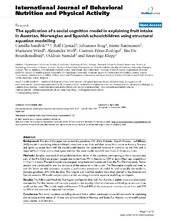| dc.contributor.author | Hartz, Ingeborg | en_US |
| dc.contributor.author | Sakshaug, Solveig | en_US |
| dc.contributor.author | Furu, Kari | en_US |
| dc.contributor.author | Engeland, Anders | en_US |
| dc.contributor.author | Eggen, Anne Elise | en_US |
| dc.contributor.author | Njølstad, Inger | en_US |
| dc.contributor.author | Skurtveit, Svetlana | en_US |
| dc.date.accessioned | 2008-05-23T12:00:15Z | |
| dc.date.available | 2008-05-23T12:00:15Z | |
| dc.date.issued | 2007-12-05 | eng |
| dc.Published | BMC Clinical Pharmacology 2007, 7:14 | en |
| dc.identifier.issn | 1472-6904 | |
| dc.identifier.uri | https://hdl.handle.net/1956/2674 | |
| dc.description.abstract | Background: The aim of this paper was to test the goodness of fit of the Attitude – Social influence – self-Efficacy (ASE) model in explaining schoolchildren's intentions to eat fruit and their actual fruit intake in Austria, Norway and Spain; to assess how well the model could explain the observed variance in intention to eat fruit and in reported fruit intake and to investigate whether the same model would fit data from all three countries. Methods: Samples consisted of schoolchildren from three of the countries participating in the cross-sectional part of the Pro Children project. Sample size varied from 991 in Austria to 1297 in Spain. Mean age ranged from 11.3 to 11.4 years. The initial model was designed using items and constructs from the Pro Children study. Factor analysis was conducted to test the structure of the measures in the model. The Norwegian sample was used to test the latent variable structure, to make a preliminary assessment of model fit, and to modify the model to increase goodness of fit with the data. The original and modified models were then applied to the Austrian and Spanish samples. All model analyses were carried out using structural equation modelling techniques. Results: The ASE-model fitted the Norwegian and Spanish data well. For Austria, a slightly more complex model was needed. For this reason multi-sample analysis to test equality in factor structure and loadings across countries could not be used. The models explained between 51% and 69% of the variance in intention to eat fruit, and 27% to 38% of the variance in reported fruit intake. Conclusion: Structural equation modelling showed that a rather parsimonious model was useful in explaining the variation in fruit intake of 11-year-old schoolchildren in Norway and Spain. For Austria, more modifications were needed to fit the data. | en_US |
| dc.language.iso | eng | eng |
| dc.publisher | BioMed Central | eng |
| dc.title | Aspects of statin prescribing in Norwegian counties with high, average and low statin consumption – an individual-level prescription database study | en_US |
| dc.type | Peer reviewed | |
| dc.type | Journal article | |
| dc.identifier.doi | https://doi.org/10.1186/1472-6904-7-14 | |
| dc.identifier.cristin | 368123 | |
